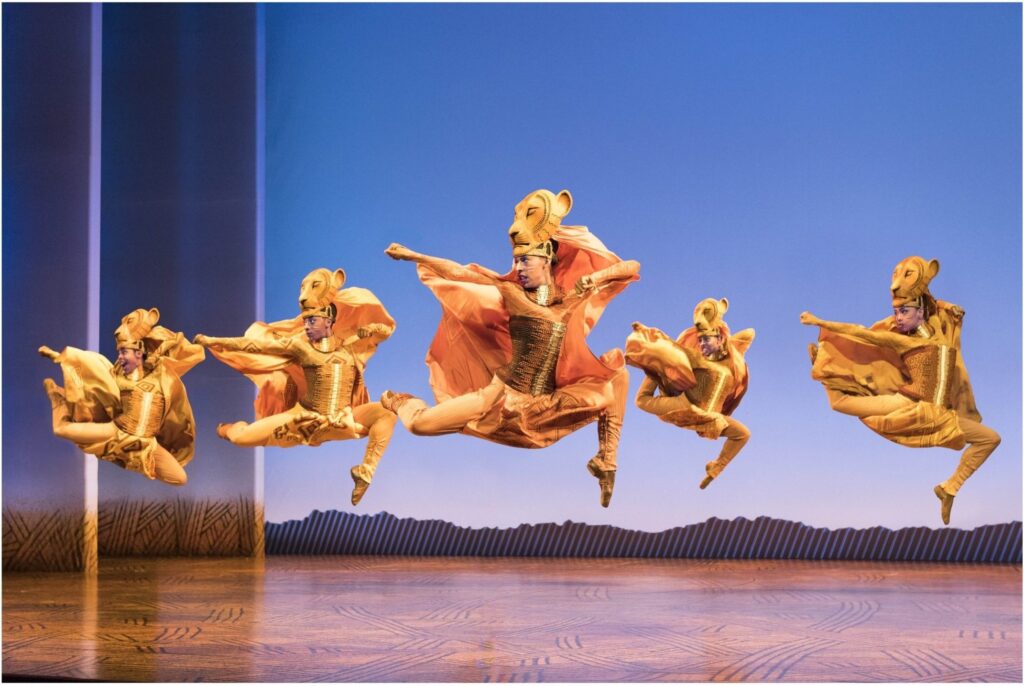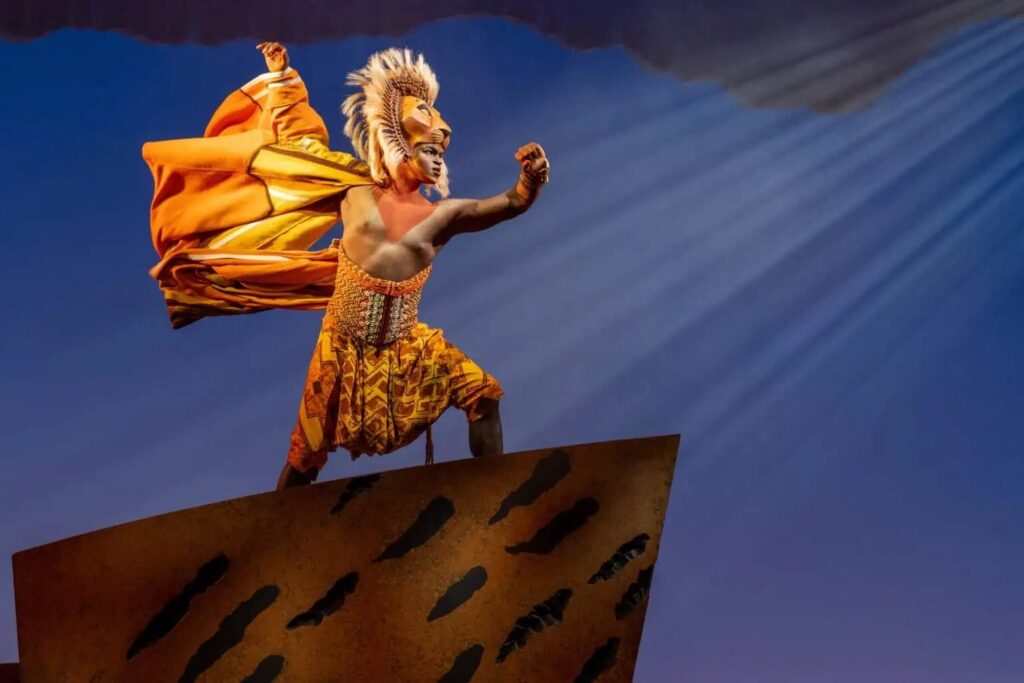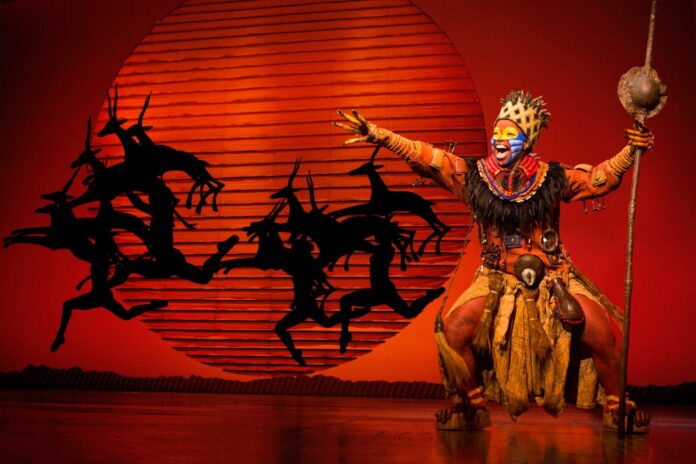Creative pathways to a career in professional costuming are countless as jungle leaves. For Quinto Ott, wardrobe supervisor of the North American touring production of Broadway’s groundbreaking The Lion King (through December 30 at Orpheum Theatre, SF), the lifelong, passionate pursuit began with a refusal.
“As a fifth grader in a children’s theater production of The Miracle Worker, they gave me a costume that I said I wasn’t going to wear. I was playing Helen Keller’s father and they’d given me a Nike wind coat and the play is set in the 1800s. It didn’t make historical sense. Let’s just say I didn’t find it sufficient. I told them I’d make my own costume,” Ott told us in late November, just days after the department he leads unloaded hundreds of costumes and other materials for the show.
For the touring production, 17 huge trucks transport 200 rod puppets, shadow puppets, and full-sized puppets and over 300 costume changes for the show. A glimpse inside the wardrobe closet and puppet gallery brings delight: Every member of the ensemble plays a hyena; the yearly upkeep and maintenance of the 20 Grasslands headdresses requires over 3,000 stalks of grass (roughly 60 pounds); 25 different animals, birds, fish and insects are represented.
Bertha the grey parrot and the Baby Elephant are operated by child actors; the heaviest costume is the Pumbaa puppet that’s worn like a backpack and weighs in at 45 pounds, and the world largest land mammals get another mention, with the longest animal puppet an elephant requiring four actors to carry it, measuring in at 13 feet long, 12 feet high, and 9 feet wide.
Ott’s journey into this incredible menagerie began, like so many stitching stories, with his grandmother. “My grandmother was a good seamstress and taught me to sew. She’d help me make a pillow, pick out fabric, choose what to make next,” he recalled. “Then later, my aunt brought sewing books, and I just started reading them and largely became self-taught.”

Ott grew up in Tucson, AZ, and in Colima, Mexico. In high school, he appeared onstage, but also fashioned costumes and went so far as to teach the school’s production course. He has toured as an actor in shows including The Phantom of the Opera and has served as wardrobe head for the New York Gilbert and Sullivan Players. As an independent contractor who now lives in New York City, Ott has, in addition to building costumes, designed and created bridalwear, recital and concert gowns, and drag queen outfits.
Anyone who has seen the national touring production of Mary Poppins has seen Ott-constructed women’s ensemble and feature character costumes; an updated production of Mikado shows off numerous redesigned and rebuilt pieces handcrafted by Ott.
And he holds a performance degree and a BA in Costume and Fashion Design and Construction from Indiana University. “I ended up with degrees in both because I’m a bass singer and so I wasn’t needed in every show. With working in the costume shop, I was able to work more shows, if not always onstage.”
Help us save local journalism!
Every tax-deductible donation helps us grow to cover the issues that mean the most to our community. Become a 48 Hills Hero and support the only daily progressive news source in the Bay Area.
Of course, there’s more to the story than strategic planning: Ott loves challenges, especially the ones presented by Lion King. “One of the ensemble dancers comes out in pointe shoes dressed as an anthill. The dress is a large cone and there’s a headpiece with a spiral that comes down around her body and has ants on it. It’s a lot to deal with, but I love it.”
The love extends to textures and illusions created, such as the show’s corsets, some covered in rope, others beading, others made of leather. “They’re made to look like a textile, but constructed with other materials, so you get a Georges Seurat affect. A lot of pieces are structural or heavy and we have corsets underpinning them. I replace bones quite often. Boning tends to be a bit project.”
A constant balancing act comes with decisions about materials. Is a single-thread, thin-weight fabric that makes sense in a day-to-day garment suitable for the demands of a long-running show like Lion King?
“The beads you see, we are always repairing,” Ott says. “But also the silks, the drapes that connects the backs on the lionesses’ heads: there’s a lot of strain on them. Over the years, the fabric degrades, there’s dry rotting in the threads, so we do a lot of repair on them. Shoes are a constant thing with lots of patching up to keep everybody’s toes inside.”
The show is carefully built to reduce the need for quick costume changes. Even so, A moment during the Lioness Chant when the gazelles run across the stage and exit into the wings becomes a NASCAR-pace backstage episode. “One dancer goes leaping offstage, hands off the handheld gazelle pieces, drops to their knees, and pulls a pin out of their headpiece, after which another dresser puts another gazelle headpiece (made up of fragmented pieces) into position using magnets. When the dancer goes back onstage, that gazelle gets surrounded by others and they pull his head apart. The change happens in about 16 counts, so that’s a pretty quick one.”

Although Ott is not in charge of masks, it’s impossible to talk about Lion King without making mention of Tony-winning director and designer Julie Taymor (along with designer Michael Curry) and her meticulous attention to detail and authenticity. She and Curry hand-sculpted and painted every prototype mask for the final versions used in the show, and Ott says that from day one Taymor was adamant about the actors’ faces being seen.
“Even with the masks, you also see the actors faces, which is cool and, honestly, changed costume design. Then there’s the number of puppets, the multiple-person costumes, like the elephant that has four actors within it, actors on stilts—the scope and scale is very different when compared to standard theatrical costuming.”
A few other examples of Taymor’s revolutionary artistry are found in specific details in the elaborately beaded corsets, hand-painted pieces, and other elements. “There’s a fan of beads that comes up the back that is repeated throughout the costumes. There are bone-like cage pieces that look like they’re made of cane, but are made of leather. There are collars indicative of tribal beading; textile hand-painted detailing, and all the silks are unique to each individual dancer and the singers in the ensemble. There’s incredibly specificity you wouldn’t notice, but it’s important because this is a show that pulls from a lot of references and aims to be authentic and to delve into the details that have a special sparkle.”
In interviews, Taymor has said she seeks the Ideograph; searching to find the simplest way to express something like an entire bamboo forest with three brush strokes. Like Japanese paintings, potency and power arrive through mechanisms, materials, forms, and lines stripped down to their barest essentials. A contemporary idea—the “double event” that has both actor and character visible and receiving credit for a role—comes from the masks that hover above and do not cover actors’ actual faces.
Ott says new strides in costume design and construction are always developing. Pieces tooled using 3-D printing may someday impact the shows beaded collars and corsets. Material “substitutes” such as rope or leather made to look like more fragile textiles or sturdy bones are explored endlessly, and one costume currently in the show already requires special, tech-centric cleaning. Ott says, “It has shells and beads and other things that mean we have to ozone clean it. Not even regular dry cleaning is safe.”
DISNEY’S THE LION KING runs through December 30, 2023 at the Orpheum Theatre, SF. More info here.





